China has now officially adopted its 12th Five-Year Plan that will guide its social and economic development for the next five years. Although the environmental targets introduced so far seem reasonably ambitious, it still remains to be seen how they will be delivered pending the publication of detailed sectoral implementation plans and policy.
The twin sessions of China’s National People’s Congress and Chinese People’s Political Consultative Conference drew to a close today and China’s 12th Five-Year Plan (2011-2015) was formally approved. As expected, the government has targeted a slower rate for growth over the next five years, with an annual growth rate of only 7 percent. Nevertheless, China’s economy as a whole will grow by nearly 40 percent to 55.8 trillion yuan (€6.09 trillion) by 2015. Urbanisation is also expected to reach 51.5 percent by 2015.
The 12th FYP has introduced 24 major targets/indicators, some of which are binding while some are not. In relation to resource and environmental protection, 7 out of the 8 targets are binding. These include a complementary 16 percent energy intensity reduction target and a 17 percent carbon intensity reduction target. In addition, China aims to increase its forest stock volume by 6 percent and increase forest coverage by 1.3 percent. This may eventually entail a larger cut in CO2 emissions as its current carbon intensity reduction targets include only fossil-fuel related emissions and not land use and forestry.
<iframe width="560" height="315" src="http://www.youtube.com/embed/MYm0VYR4wX4" frameborder="0" allowfullscreen></iframe>
The Chinese government also aims to increase the share of non-fossil fuel in its primary energy consumption to 11.4 percent, with large investments expected in the nuclear, hydro and wind power sectors. There has also been some breakthrough in pollution control: in addition to the 8 percent reduction target for sulphur dioxide and chemical oxygen demand, the Chinese government has also introduced a new 10 percent reduction target for nitrogen oxides and ammonia nitrogen. A reduction target for nitrogen oxides, which comes mainly from coal power plants in China, is seen as a significant move that seeks to curb the environmental impacts of China’s heavy reliance on coal power.
The 12th FYP, however, does not include an energy consumption cap which had been suggested at 4 billion tonnes of coal equivalent by the former minister of the National Energy Administration Zhang Guobao. It also does not contain detailed information about the introduction of a carbon tax and trading scheme. Many sector-specific targets and policy will only be revealed later this year in individual sectoral plans.
Overall, although China’s environmental ambitions for the next five years are reasonable, a higher energy intensity target would be desirable in order to stimulate real structural shifts. It is also still too early to know if the targets will be backed by innovative and effective policy measures. As E3G’s Shin Wei Ng says,
"What is certain is that, if implemented, the 12th FYP will create a huge market for clean technologies in China."
To tap into the domestic and international markets, the Chinese government is also introducing a series of medium term (2011-2015) development plans for seven strategic emerging industries. These include new energy, alternative-fuel vehicles and energy-saving and environmental protection industries.
"By combining binding targets with an ambitious industrial strategy, the Chinese government is ready to engage the rest of the world on the low carbon race,”
she continued.
Shin Wei also wrote an opinion piece that appeared on ChinaDialogue.
Nick Mabey’s views on the 12th Five-Year-Plan were recorded by Euractiv.


